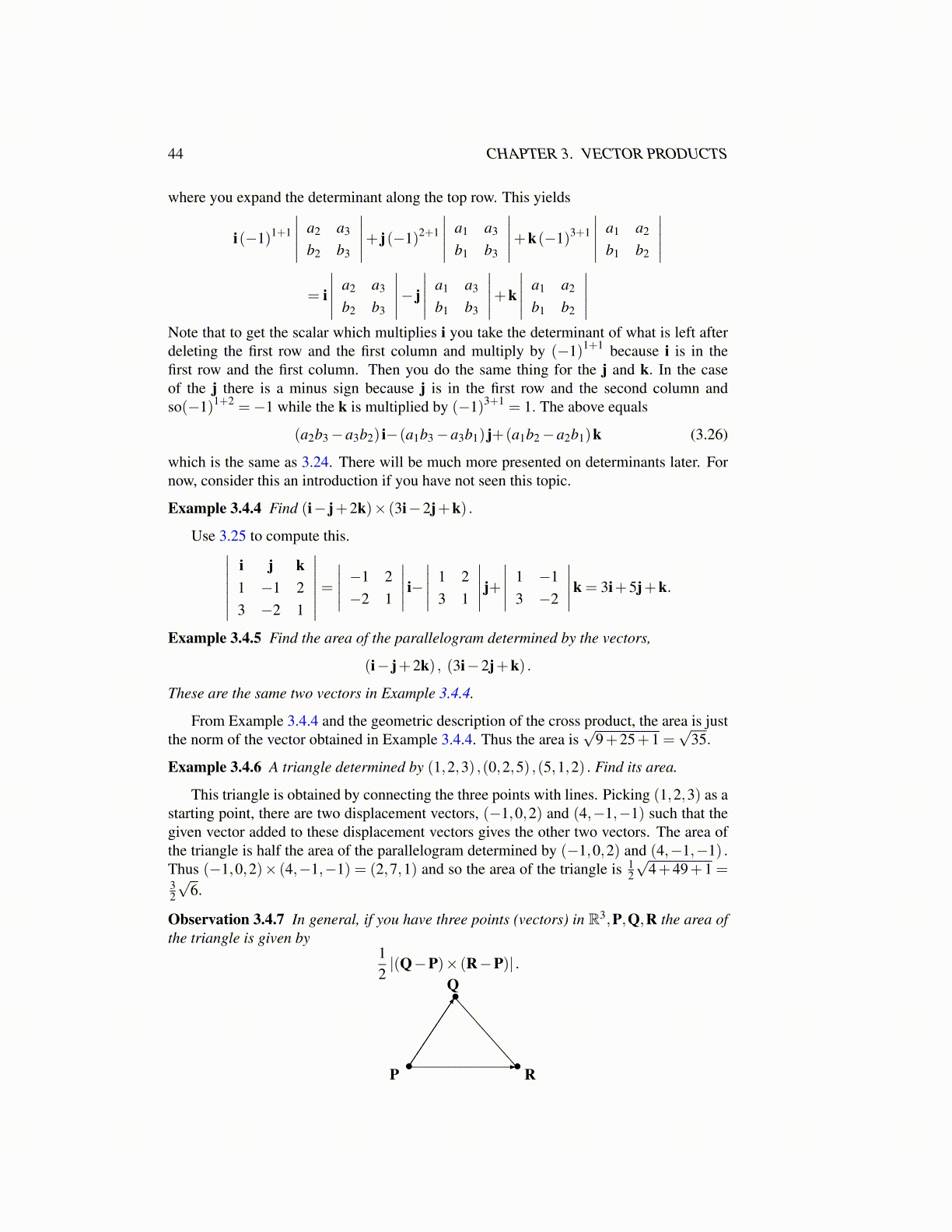
44 CHAPTER 3. VECTOR PRODUCTS
where you expand the determinant along the top row. This yields
i(−1)1+1
∣∣∣∣∣ a2 a3
b2 b3
∣∣∣∣∣+ j(−1)2+1
∣∣∣∣∣ a1 a3
b1 b3
∣∣∣∣∣+k(−1)3+1
∣∣∣∣∣ a1 a2
b1 b2
∣∣∣∣∣= i
∣∣∣∣∣ a2 a3
b2 b3
∣∣∣∣∣− j
∣∣∣∣∣ a1 a3
b1 b3
∣∣∣∣∣+k
∣∣∣∣∣ a1 a2
b1 b2
∣∣∣∣∣Note that to get the scalar which multiplies i you take the determinant of what is left afterdeleting the first row and the first column and multiply by (−1)1+1 because i is in thefirst row and the first column. Then you do the same thing for the j and k. In the caseof the j there is a minus sign because j is in the first row and the second column andso(−1)1+2 =−1 while the k is multiplied by (−1)3+1 = 1. The above equals
(a2b3−a3b2) i−(a1b3−a3b1) j+(a1b2−a2b1)k (3.26)
which is the same as 3.24. There will be much more presented on determinants later. Fornow, consider this an introduction if you have not seen this topic.
Example 3.4.4 Find (i− j+2k)× (3i−2j+k) .
Use 3.25 to compute this.∣∣∣∣∣∣∣i j k1 −1 23 −2 1
∣∣∣∣∣∣∣=∣∣∣∣∣ −1 2−2 1
∣∣∣∣∣ i−∣∣∣∣∣ 1 2
3 1
∣∣∣∣∣ j+∣∣∣∣∣ 1 −1
3 −2
∣∣∣∣∣k = 3i+5j+k.
Example 3.4.5 Find the area of the parallelogram determined by the vectors,
(i− j+2k) , (3i−2j+k) .
These are the same two vectors in Example 3.4.4.
From Example 3.4.4 and the geometric description of the cross product, the area is justthe norm of the vector obtained in Example 3.4.4. Thus the area is
√9+25+1 =
√35.
Example 3.4.6 A triangle determined by (1,2,3) ,(0,2,5) ,(5,1,2) . Find its area.
This triangle is obtained by connecting the three points with lines. Picking (1,2,3) as astarting point, there are two displacement vectors, (−1,0,2) and (4,−1,−1) such that thegiven vector added to these displacement vectors gives the other two vectors. The area ofthe triangle is half the area of the parallelogram determined by (−1,0,2) and (4,−1,−1) .Thus (−1,0,2)× (4,−1,−1) = (2,7,1) and so the area of the triangle is 1
2
√4+49+1 =
32
√6.
Observation 3.4.7 In general, if you have three points (vectors) in R3,P,Q,R the area ofthe triangle is given by
12|(Q−P)× (R−P)| .
• •
•
P
Q
R